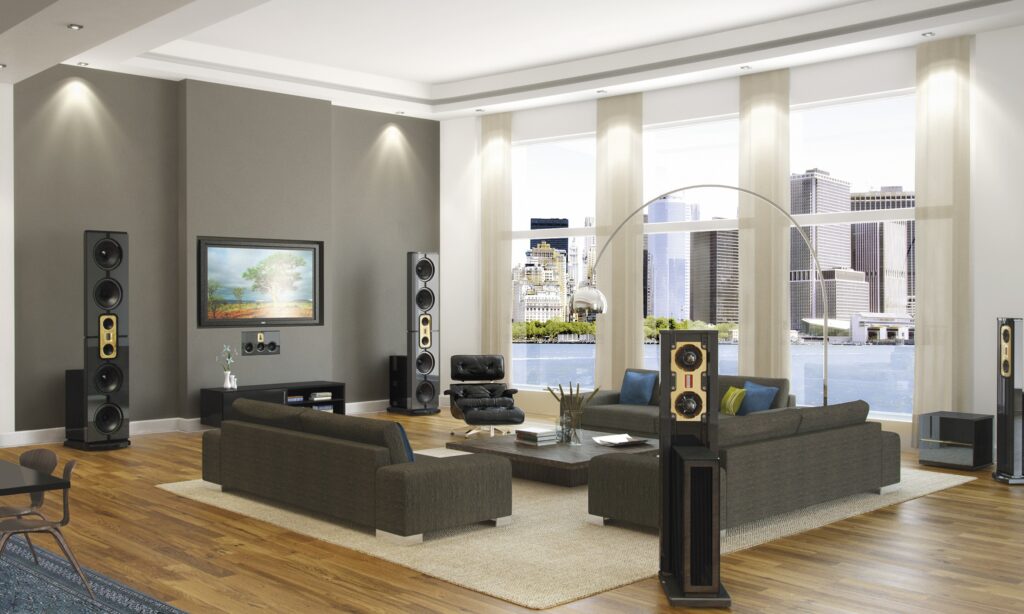When most people think of stereo system speakers, they might envision sleek, high-fidelity speakers that fill a room with immersive sound. But the journey to the stereo speakers we know today is a tale of continuous innovation, blending acoustics with cutting-edge technology. From the early days of acoustic horn speakers to the latest advancements in wireless, smart speakers, the evolution of home audio systems is a fascinating mix of art, science, and craftsmanship.
The Birth of Sound Reproduction: The Horn and the First Speakers
In the late 19th and early 20th centuries, sound reproduction was a mechanical art. The earliest speakers were often just large, cone-shaped horns attached to phonographs and other sound-reproducing devices. These early speakers, used in gramophones and early radios, were designed to amplify the vibrations from the stylus or the radio signal.
While these horn speakers had a distinct character and were often valued for their unique tonal qualities, they had limited frequency response, and distortion was prevalent. The horns themselves became a symbol of the birth of home audio entertainment, a primitive yet charming attempt to reproduce music in the home.
The Rise of Dynamic Drivers: The Birth of Modern Speakers
The 1920s and 1930s saw a significant shift in speaker technology with the advent of the dynamic driver. This is the type of speaker most of us are familiar with today. Dynamic drivers consist of a diaphragm, a voice coil, and a magnet, and they operate based on electromagnetic principles to move the diaphragm and create sound waves.
During this time, iconic brands like JBL and Klipsch began experimenting with new materials and designs. This era marked the birth of high-fidelity (hi-fi) sound systems, aimed at accurately reproducing recorded music with as little distortion as possible. The introduction of full-range speakers, such as the famous Klipschorn, which is still in production today, showed that a speaker could both deliver high output and possess the depth of sound that could rival a live performance.
The Advent of Stereo Sound: Two Channels, Infinite Possibilities
In the 1950s, with the arrival of stereo recording, a paradigm shift occurred in how we listened to music. Stereo sound, which uses two independent channels to create the illusion of space and directionality, revolutionized the speaker industry. Suddenly, there was a demand for stereo system speakers that could create an immersive experience, not just a one-dimensional sound.
Bookshelf speakers, floor-standing speakers, and subwoofers all came into being to meet this new demand. Two-way and three-way systems became standard, where a dedicated woofer (low-frequency driver) handled the bass, a mid-range driver handled the middle frequencies, and a tweeter managed the treble. This tri-way division of labor allowed stereo systems to reproduce music with greater clarity and depth.
The competition between high-end audio manufacturers like Bose, Sony, and Bang & Olufsen fueled technological improvements, leading to innovations in speaker enclosures, driver materials, and crossover designs. Speaker enclosures, or cabinets, became a crucial factor in the sound output, leading to designs that minimized distortion and optimized resonance, such as the sealed box, ported, and transmission line enclosures.
The Digital Revolution: The Rise of Compact and Wireless Speakers
By the 1980s and 1990s, the arrival of digital technology began reshaping stereo systems again. The advent of compact disks (CDs), followed by digital audio formats like MP3s, fundamentally changed how we interacted with music. As home audio systems became more digitized, speakers needed to evolve to meet the new demands.
One of the key trends that emerged during this period was the increasing miniaturization of speakers. The introduction of the compact bookshelf speaker allowed audiophiles to set up high-quality systems in smaller spaces, while manufacturers like Bose pushed the limits of sound engineering with their now-iconic Acoustimass systems, which use small satellite speakers paired with a subwoofer to produce a surprisingly full sound.
Perhaps the most transformative change in recent years has been the introduction of wireless speakers. Driven by the rise of Bluetooth and Wi-Fi technologies, wireless speakers have allowed for unprecedented convenience and flexibility in how we listen to music. Brands like Sonos and Bose lead the charge in producing speakers that not only deliver high-quality audio but also integrate seamlessly into a smart home ecosystem.
Smart speakers—such as the Amazon Echo and Google Nest Audio—have brought voice assistants into the world of home audio, turning the act of controlling music into an interactive experience. These speakers use advanced software to optimize sound output for the room’s acoustics, further blurring the lines between high-end audiophile systems and consumer-grade technology.

